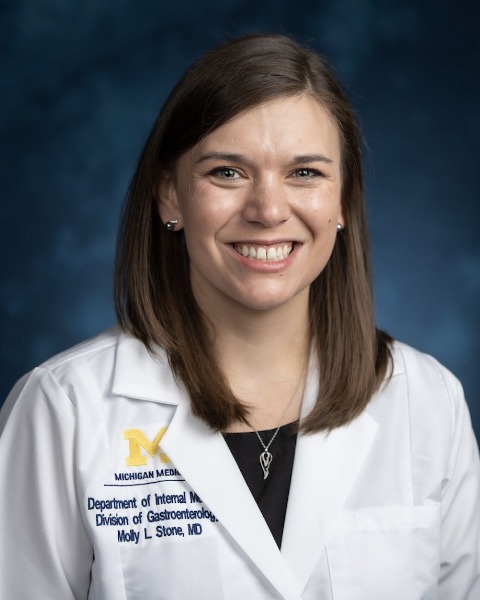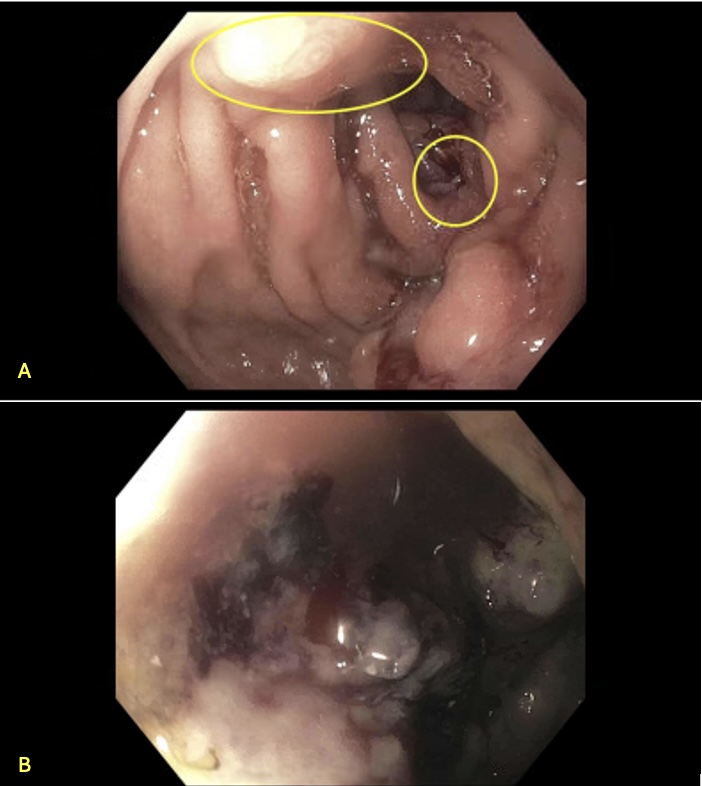Tuesday Poster Session
Category: Colon
P3793 - From Duodenum to Colon in 60 Seconds
Tuesday, October 29, 2024
10:30 AM - 4:00 PM ET
Location: Exhibit Hall E

Has Audio

Molly Stone, MD
University of Michigan
Ann Arbor, MI
Presenting Author(s)
Molly Stone, MD, Jessica L. Sheehan, MD, MSc, Allen Lee, MD
University of Michigan, Ann Arbor, MI
Introduction: Colorectal cancer can spread by local invasion into surrounding structures however rarely causes fistula formation within the bowel. This case highlights the importance of thorough endoscopic evaluation with an uncommon presentation of colon cancer diagnosed on upper endoscopy.
Case Description/Methods: A 63 year-old female with a history of COPD and hypothyroidism presented to the emergency department with generalized weakness, nausea, and diarrhea. Laboratory workup was notable for iron deficiency anemia and CT abdominal and pelvis identified a large necrotic mass at the hepatic flexure. She was subsequently referred for EGD and colonoscopy, during which she was found to have a necrotic appearing mass in the duodenal bulb. While maneuvering through the duodenal sweep, the gastroscope was passed directly from the duodenal bulb into the ascending colon where a large, firm, and necrotic mass was identified. Biopsies of the duodenal and colonic masses revealed adenocarcinoma of the colon. Colonoscopy was unable to traverse necrotic mass but was without other significant abnormalities. She was started on TPN for nutritional support and neoadjuvant immunotherapy prior to planned right hemicolectomy with Whipple procedure.
Discussion: Colorectal cancer incidence has been decreasing though remains fourth most commonly diagnosed malignancy in the United States. Colo-duodenal fistula is a rare presentation of colorectal cancer with experience limited to case series; among 50 patients undergoing pancreaticoduodenectomy with colon resection only eight had an underlying pathology of colon cancer. For patients diagnosed with colo-duodenal fistula, previous case reports suggest hemicolectomy with pancreaticoduodenectomy is the resection of choice with prior documentation of complete resection with clear margins. There has been a single case report of immunotherapy with pembrolizumab combined with radiation therapy leading to closure of colo-duodenal fistula prior to surgery in a patient with severely compromised nutrition. With ongoing advancement in the use of neoadjuvant immunotherapy, more information is needed regarding the role and timing of immunotherapy, radiation and surgery.

Disclosures:
Molly Stone, MD, Jessica L. Sheehan, MD, MSc, Allen Lee, MD. P3793 - From Duodenum to Colon in 60 Seconds, ACG 2024 Annual Scientific Meeting Abstracts. Philadelphia, PA: American College of Gastroenterology.
University of Michigan, Ann Arbor, MI
Introduction: Colorectal cancer can spread by local invasion into surrounding structures however rarely causes fistula formation within the bowel. This case highlights the importance of thorough endoscopic evaluation with an uncommon presentation of colon cancer diagnosed on upper endoscopy.
Case Description/Methods: A 63 year-old female with a history of COPD and hypothyroidism presented to the emergency department with generalized weakness, nausea, and diarrhea. Laboratory workup was notable for iron deficiency anemia and CT abdominal and pelvis identified a large necrotic mass at the hepatic flexure. She was subsequently referred for EGD and colonoscopy, during which she was found to have a necrotic appearing mass in the duodenal bulb. While maneuvering through the duodenal sweep, the gastroscope was passed directly from the duodenal bulb into the ascending colon where a large, firm, and necrotic mass was identified. Biopsies of the duodenal and colonic masses revealed adenocarcinoma of the colon. Colonoscopy was unable to traverse necrotic mass but was without other significant abnormalities. She was started on TPN for nutritional support and neoadjuvant immunotherapy prior to planned right hemicolectomy with Whipple procedure.
Discussion: Colorectal cancer incidence has been decreasing though remains fourth most commonly diagnosed malignancy in the United States. Colo-duodenal fistula is a rare presentation of colorectal cancer with experience limited to case series; among 50 patients undergoing pancreaticoduodenectomy with colon resection only eight had an underlying pathology of colon cancer. For patients diagnosed with colo-duodenal fistula, previous case reports suggest hemicolectomy with pancreaticoduodenectomy is the resection of choice with prior documentation of complete resection with clear margins. There has been a single case report of immunotherapy with pembrolizumab combined with radiation therapy leading to closure of colo-duodenal fistula prior to surgery in a patient with severely compromised nutrition. With ongoing advancement in the use of neoadjuvant immunotherapy, more information is needed regarding the role and timing of immunotherapy, radiation and surgery.

Figure: A. Endoscopic appearance showing connection from second portion of duodenum just distal to ampulla of vater to malignant colon lesion. B. Distal portion of fistula with colonic malignancy.
Disclosures:
Molly Stone indicated no relevant financial relationships.
Jessica Sheehan indicated no relevant financial relationships.
Allen Lee: Atmo – Consultant, Grant/Research Support. GSK – Consultant.
Molly Stone, MD, Jessica L. Sheehan, MD, MSc, Allen Lee, MD. P3793 - From Duodenum to Colon in 60 Seconds, ACG 2024 Annual Scientific Meeting Abstracts. Philadelphia, PA: American College of Gastroenterology.
